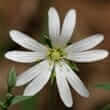Background
- Eyebright's genus name, Euphrasia, is derived from the Greek "euphrosyne," the name of one of the three Graces who was distinguished for joy and mirth. Eyebright was used as early as the time of Theophrastus (Greek philosopher and biologist, student of Plato and Aristotle) and Dioscorides (Greek philosopher (circa AD 64) who authored a pharmacological account of plants), who prescribed infusions for topical applications in the treatment of eye infections. During the middle ages, eyebright was widely prescribed by medical practitioners as an eye medication, as a cure for "all evils of the eye."
- In Europe, the herb eyebright (Euphrasia officinalis) has been used for centuries as a rinse, compress, or bath against eye infections and other eye-related irritations (a use reflected in many of its vernacular names). When taken by mouth, eyebright has been used to treat inflammation of nasal mucous membranes and sinusitis.
- Eyebright is high in iridoid glycosides such as aucubin. In several laboratory studies, this constituent has been found to possess hepatoprotective (liver protecting) and antimicrobial activity. There is limited clinical research assessing the efficacy of eyebright in the treatment of conjunctivitis (pink eye), and the use of eyebright for other indications has not been studied in clinical trials.
- Little data exists regarding the safety and toxicity of eyebright. A concern regarding the opthamalogic (eye) use of eyebright is the potential for contamination. The U.S. Food and Drug Administration (FDA) has not evaluated eyebright for a generally recognized safe (GRAS) status.
References
Natural Standard developed the above evidence-based information based on a thorough systematic review of the available scientific articles. For comprehensive information about alternative and complementary therapies on the professional level, go to . Selected references are listed below.
- Bartholomaeus A, Ahokas J. Inhibition of P-450 by aucubin: is the biological activity of aucubin due to its glutaraldehyde-like aglycone? Toxicol Lett 1995;80(1-3):75-83.
View Abstract - Bermejo BP, Diaz Lanza AM, Silvan Sen AM, et al. Effects of some iridoids from plant origin on arachidonic acid metabolism in cellular systems. Planta Med 2000;66(4):324-328.
View Abstract - Chang I, Yamaura Y. Aucubin: a new antidote for poisonous amanita mushrooms. Phytother Res 1993;7:53-56.
- Chang I. Antiviral activity of Aucubin against Hepatitis B virus replication. Phytother Res 1997;11(3):189-192.
- Chang IM. Liver-protective activities of aucubin derived from traditional oriental medicine. Res Commun Mol Pathol Pharmacol 1998;102(2):189-204.
View Abstract - Ersoz T, Berkman MZ, Tasdemir D, et al. An iridoid glucoside from Euphrasia pectinata. J Nat Prod 2000;63(10):1449-1450.
View Abstract - Hattori M, Kawata Y, Inoue K, et al. Transformation of aucubin to new pyridine monoterpene alkaloids, aucubinines A and B, by human intestinal bacteria. Phytother Res 1990;4(2):66-70.
- Lee DH, Cho IG, Park MS, et al. Studies on the possible mechanisms of protective activity against alpha- amanitin poisoning by aucubin. Arch Pharm Res 2001;24(1):55-63.
View Abstract - Mokkapatti R. An experimental double-blind study to evaluate the use of Euphrasia in preventing conjunctivitis. Brit Homoeopath J 1992;1(81):22-24.
- Porchezhian E, Ansari SH, Shreedharan NK. Antihyperglycemic activity of Euphrasia officinale leaves. Fitoterapia 2000;71(5):522-526.
View Abstract - Recio MC, Giner RM, Manez S, et al. Structural considerations on the iridoids as anti-inflammatory agents. Planta Med 1994;60(3):232-234.
View Abstract - Salama O, Sticher O. Iridoid glucosides from Euphrasia rostkoviana. Part 4. Glycosides from Euphrasia species. Planta Med 1983;47:90-94.
View Abstract - Stoss M, Michels C, Peter E, et al. Prospective cohort trial of Euphrasia single-dose eye drops in conjunctivitis. J Altern Complement Med 2000;6(6):499-508.
View Abstract - Suh NJ, Shim CK, Lee MH, et al. Pharmacokinetic study of an iridoid glucoside: aucubin. Pharm Res 1991;8(8):1059-1063.
View Abstract - Ulubelen A, Topcu G, Eris C, et al. Terpenoids from Salvia sclarea. Phytochemistry 1994;36(4):971-974.
View Abstract







